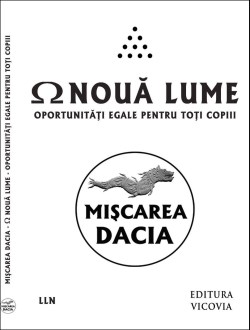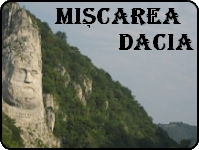 Vă invit să vă alăturaţi grupului Facebook Mişcarea DACIA, ce-şi propune un alt fel de a face politică!
Vă invit să vă alăturaţi grupului Facebook Mişcarea DACIA, ce-şi propune un alt fel de a face politică!Citiţi partea introductivă şi proiectul de Program, iar dacă vă place, veniţi cu noi !
O puteţi face clicând alături imaginea, sau acest link
Posts Tagged ‘Hyperianism’
Hyperian History Of The World (3rd Century)
“Hyperian History Of The World (3rd Century)
In the 3rd Century, the Hellenic world, centred on Alexandria, was awash in various, conflicting sects of Christianity, ranging from those more radical and more Jewish, to those more pagan, such as the Gnostic sects, as well as many other non-christian sects of Greek/Roman paganism. In the previous century, the religious element of these sects had taken precedence over any kind of intellectual, philosophical elements. But in the 3rd century, a great genius appeared in the world who would revive Greek philosophy and combine it with the religious sensibility of the time to produce a truly intelligent and intellectual religion. The Genius was Plotinus and his philosophical religion became known as Neoplatonism.
After travelling to Alexandria seeking philosophical wisdom, Plotinus came across a man called Ammonius Saccas, whose lectures on the philosophy of Plato so affected Plotinus that he immediately began studying under this new teacher. After many years of study under Ammonius Saccas, Plotinus began travelling around gaining further wisdom from Persian, Indian and Arab philosophers before finally settling in Rome towards the end of his life, where he spread his teachings around the great city.
Plotinus’s philosophical religion is basically the philosophy of Plato turned into a religion. Plotinus himself insisted that he was not creating anything new, but was rather producing the culmination of Plato’s philosophy. In the system of Plotinus, everything has its source in what he called The One. The One is essentially the arche, the source of everything. But for Plotinus, The One, as the source of everything, is very similar to Pythagoras’s concept of the point that contains all other points, i.e. The One is purely dimensionless and immaterial, yet contains within it everything else in the universe.
Plotinus’s system consists of a series of emanations starting from The One. The first thing that emanates from The One is The Nous, basically the same Nous as that of Anaxagoras. The Nous is the mind or the intellect of the universe, the thing that guides it and controls it. For Plotinus, the Nous contains within it all of the perfect Forms that Plato had spoken of. As the mind of the universe, the Nous knows everything about the universe and thinks all possible thoughts simultaneously.
The next emanation is the Psyche or the soul, emanating from the Nous. The Psyche is equivalent to Plato’s Demiurge. Whereas the Nous thinks everything simultaneously, the Psyche thinks slowly and as a linear process. The Psyche can access the Forms present in the Nous and use them to create the next emanation which is Nature, or the physical world, which is, as Plato said, an inferior copy of the Forms in the Nous. The Psyche is also split into two parts, firstly the upper part which is the World Soul, the collective soul of the world, and secondly, the lower part which takes the form of all the individual souls in the universe.
As these individual souls are only one emanation away from the physical world, Plotinus explains that these souls take the physical world to be true reality, when, in fact, True reality is mental rather than material, the true Forms in the Nous rather than the inferior copies of them in Nature. For Plotinus, the task of our souls is to leave behind the physical world and travel back up the emanations, firstly to the upper Psyche, or World Soul, then into the Nous itself where the True Forms are, and finally back to The One, which contains everything. This idea expands on Anaximander’s original concept that the universe begins as apeiron and shall return to apeiron.
Unfortunately, Plotinus’s religion, based on reason, rationality and mathematics, as well as the ideas of the greatest of geniuses of Ancient Greece, failed to take hold of Europe which, instead, adopted the absurd, irrational, faith-based version of Christianity which took over the Roman empire.
Of course, it is not too late to abandon the absurdity that is Christianity and revive the brilliant ideas of Plotinus, a religion which would far better have served the Romans and, indeed, the rest of the world. A religion based on reason, philosophy and mathematics is precisely what the world needs right now. The central idea can be summed up by Plotinus’s supposed last words: “Try to raise the divine in yourselves to the divine in the all.” If that’s not Hyperian, I don’t know what is.”
– Azure Circe – Hyperian

Hyperianism vs. The Movement

‘There are a number of you here who are intimately familiar with the work of Mike Hockney, Michael Faust, Adam Weishaupt, and the Armageddon Conspiracy site. Those of you who are know there was a movement that started ten years ago that was simply called “The Movement.” Under this movement was promoted the rational ideology of Illuminism and the political ideology called Meritocracy. It’s time for everyone to know a brief history of that, why it failed and how Hyperianism has risen from the ashes to complete what was started ten years ago.
The Movement was a 21st century incarnation of a millennia old struggle to defeat the Old World Order and liberate the divine spark within every single person thereby ushering in an age of Enlightenment. It was originally conceived of as a grass roots movement to awaken the common, working class folk to their true potential thereby removing their shackles and defeating the OWO. From the beginning, the Movement was plagued with all sorts of crazy individuals who ended up undermining the entire project. Too many people came to the movement without properly going through their own “metaphorical suicide”, destroying the ingrained brainwashing they received over the years. As a result, there were dozens and dozens of offshoot groups all purporting to be Illuminists and Meritocrats.
The Movement didn’t have unity, so as is the case with any group or movement without a central structure, it fractured and broke down, splintering off into factions all vying for power and recognition. It was hoped that there would arise within this grassroots movement a few upstanding and courageous individuals who would rise to the top and take the reins of leadership, but the exact opposite happened; The Movement was plagued by people who were all talk and who wouldn’t walk the walk. They spoke of wanting to overthrow the OWO, but never actually did anything to make that happen. Instead of getting courageous, world historic individuals, there were only legions of ignavi pretending to care.
Due to the term Illuminism being dragged through the mud by different groups, it was decided that a new approach would be taken with a brand-new name. These terms are, after all, just names and names can be changed and rewritten as our movement has done for literally thousands of years. The only way we’ve been able to survive and make any sort of impact has been by adapting. This is what we’ve done; we’ve adapted yet again, but this time, the time is ripe for a real revolution. This time, Hyperianism will be on the map as the incarnation that made it, the incarnation that actually accomplished what we’ve been longing to accomplish since the time of the ancients. We’ve learned from the past mistakes of The Movement and know now what must be done to liberate the divine spark within every individual and usher in the age of Reason. Every single one of us here is taking part in the continuation of the ever-living current of Reason. We’re all links in an age-old chain and it’s our sacred duty to make this vision a reality.
With that being said, promoting “The Movement” will only be retreading old ground. Hyperianism IS “The Movement” in all but name, except it has learned from the mistakes of the past and adapted. Simply put, The Movement died years ago and should be laid to rest. Anyone interested in continuing where it left off should be doing all they can to promote Hyperianism and #ProjectFallenStar.’
By Apollonius
Istoria Hiperiană a lumii (secolul al IV-lea î.Hr., Partea I)
Tags: Anaxagoras, Apollo, Dionis, Forme, Heraclit, HiperUmanitate, Hyperianism, Parmenide, Pitagora, Platon, Raţiunea, Socrate












